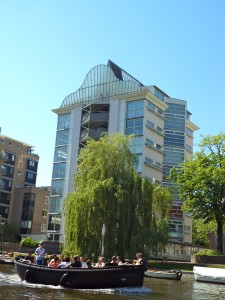By Malia Teske
Amsterdam is a global city and a top European financial center that has gained a reputation for its commitment to sustainability. In the Netherlands, sustainable development considerations have long been integrated into urban planning and new building codes (Gauzin-Müller & Favet, 2002, p. 76). In Dutch cities, sustainability is an essential component in the design of new housing developments (Cousins, 2009, p. 5). The Netherlands has found themselves at the forefront of sustainable housing construction, with many of their best examples located in the capital city of Amsterdam. Architects, built-environment professionals and policy makers have credited the Netherlands for its groundbreaking sustainable housing designs (Cousins, 2009, p. 1). The Dutch government at both the local and national level has played a large role in making high quality housing design and sustainability a priority in developmental policies (Cousins, 2009, p. 9). In Amsterdam, the government’s commitment to sustainability has been essential in realizing the many sustainable initiatives throughout the city.
The geographic context of Amsterdam provides insight into the government’s early commitment to sustainable urban development. The densely populated city of Amsterdam is located on the second largest port in the country, connected to the North Sea through the North Sea Canal. Amsterdam’s coastal lowlands and reclaimed land from the sea rise a mere two meters above sea level (“Topography & Climate in Amsterdam”). Historical concern about the vulnerability of Dutch people to rising sea levels and the Netherland’s small land mass has been well documented (Cousins, 2009, p. 19). Amsterdam’s geographic context has increased the relevance of environmental issues for government officials and citizens alike.
In addition to the geographic relevance of environmental issues, Dutch policy-making culture has also been cited for its contribution to the development of high quality and sustainable design policies. Dutch policy is guided by a decision-making process that is commonly described in terms of its “consensus culture” (Cousins, 2009, p. 9). Intended to protect the citizen’s rights, Dutch policy makers seek to reach an agreement among the varied interest groups represented, including the community. This policy model has contributed to a strong culture of collaboration and partnerships in which all citizens can contribute to their environment and voice their opinions on the qualities of urban space (Cousins, 2009, p. 10). While this decision-making model and consensus culture has been praised it has also been criticized for prolonging the decision-making process and slowing down project timelines (Cousins, 2009, p. 11).
In the Netherlands, sustainable development concerns became integrated into policies and development projects beginning in the late 1960s and continuing every since. In 1974, the Dutch government published its first energy policy document and subsidized the construction of several energy efficient housing projects (Cousins, 2009, p. 19). In the policy document, lighting and heating efficiency were evaluated and other sustainable techniques were explored for future building requirements. In the 1980s, Amsterdam’s municipal government launched an extensive urban renovation program, which in addition to expanding the electric metro line and redeveloping public spaces, regenerated former industrial lands and created new sustainable districts (Gauzin-Müller, & Favet, 2002, p. 76). In 1995, the planning document “Sustainable Building Plan: Investing for the future” was published by the Dutch government, outlining sustainable housing and building criteria now substantially integrated into procedures throughout the Dutch building sector (Gauzin-Müller, & Favet, 2002, p. 21). These governmental policies have helped push developers, designers, and contractors to the forefront of sustainable housing development.
During Amsterdam’s urban renovation program, the site of the old municipal drinking-water company was selected for a large-scale sustainable housing development project called the GWL District. Due to the country’s intense land shortage, many new housing developments in the Netherlands have been constructed on large brownfield sites like the one chosen for the GWL District (Cousins, 2009, p. 9). The developers of the GWL District wanted to combine high density housing with community desires for a large and “green” car free area (Gauzin-Müller, & Favet, 2002, p. 77). The project consists of 600 housing units as well as shops and services. A consultant was hired to draw up the environmental building specifications; in construction the following sustainable design elements were used: non-hazardous materials, solar gain, good insulation, rainwater for toilet flushing, and heating via a gas co-generator (Gauzin-Müller, & Favet, 2002, p. 78). The project was a successful revitalization effort, significantly decreasing the ecological footprint of the site and the buildings that were renovated.
Since the GWL District housing project, sustainable development policies and initiatives in Amsterdam have expanded and matured. In 2011, the Amsterdam city government published a sustainability document entitled “Amsterdam Definitely Sustainable 2011 – 2014.” With the ambitious goal of becoming a carbon neutral city, this document outlines a comprehensive program focusing on four pillars of sustainability: climate and energy, mobility and air quality, sustainable innovative economy, and materials and consumers (“Sustainable Programme”). An example of a current sustainable initiative is the Amsterdam Smart City project. This ongoing project is a partnership between businesses, public authorities, research institutions, and the people of Amsterdam, seeking to create a more sustainable and energy efficient city through the implementation of a large number of innovative programs.
As a result of the Smart City project, the Amsterdam Metropolitan Area has been transformed into an urban living lab that allows project participants to both test and demonstrate innovative products and services (“Amsterdam Smart City”). The sustainable investments made into the city have transformed Amsterdam’s urban environment by fueling local economic growth and elevating the quality of life. The program provided the city of Amsterdam with an opportunity to capitalize on the sustainable image it is creating for itself through its policies, projects, and initiatives.
References:
Cousins, M. (2009). Design quality in new housing: Learning from the Netherlands. Abingdon, Oxon: Taylor & Francis.
Gauzin-Müller, D., & Favet, N. (2002). Sustainable architecture and urbanism: Concepts, technologies, examples. Basel: Birkhauser.
“Amsterdam Smart City” http://amsterdamsmartcity.com/
“Sustainability Programme.” Ansterdam.nl. http://www.amsterdam.nl/gemeente/organisatie-diensten/dienst-ruimtelijke/making-amsterdam/portfolio/sustainability-progr/
“Topography & Climate in Amsterdam.” http://www.expatcenteramsterdam.com/expat/amsterdam-holland/about-amsterdam.php?hoofd=1&sub=1&art=94
Image sources:
GWL District, Amsterdam http://farm5.staticflickr.com/4078/4755104186_fccebd6b9c_b.jpg



